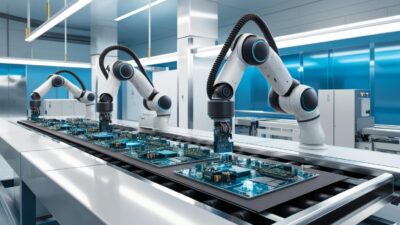There's been a push to reshore manufacturing jobs to the U.S. But manufacturers are struggling to hire Gen Z workers even as their workforce ages. Are there practical ways to make manufacturing appealing to younger workers?

Manufacturing is in the spotlight right now, as the Trump administration moves to institute tariffs as a means of reshoring manufacturing jobs.
But manufacturing has faced a labor shortage for years now, and bridging the gap between available manufacturing jobs and those qualified to fill those roles will take time.
Some of the problem lies with a lack of knowledge that certain roles exist. Skills-based jobs that are not quite blue-collar, not quite white-collar represent a new wave of job openings, according to the Wall Street Journal. But a number of people report finding out about those roles haphazardly.
At the end of 2024, only about 8% of U.S. workers held manufacturing jobs, according to the New York Times. The median age of manufacturing workers in 2024 was 44.3, according to the Bureau of Labor Statistics. And younger workers seem put off by the prospect of working in the industry.
It’s something Aaron Prather, the director of robotics and autonomous systems at ASTM International, has thought about.
Part of the problem, Prather said, is the way manufacturing is presented in classrooms as being dirty and archaic, a representation that is a far cry from the modern plant floor.
“Some of them, sadly, are still looking at textbooks that show factories of earlier times and how they were just dark and dirty places, and that’s just not what modern manufacturing is,” he said in an exclusive interview with WTWH Media.
Another factor is that manufacturing jobs are rarer in the U.S. As younger people seek out their career paths, they might not know anyone who works in that industry, so they don’t have any grounding in what those careers entail.
“They don’t know this is not your grandfather’s manufacturing anymore,” he noted.
Most Americans want U.S.-based manufacturing, but there’s a catch
It seems a lot of Americans believe the country would be better off if more Americans worked in manufacturing. This comes from a 2024 poll conducted by the Cato Institute.
The institute asked about 2,000 people if they believed the country would be better off if more Americans worked in manufacturing. About 80% of the respondents agreed. But only about 25% of respondents would take a job in the sector. Only about 2% of the respondents currently work in manufacturing.
“That’s always been the big catch-22 we see with all of this,” Prather said.
Automation is a method of tackling manufacturing’s labor crisis, but it can only go so far. Prather said he’s witnessed people complain about automation eliminating jobs, but when he asks those people if they’d actually do those jobs, they frequently respond in the negative.
“At the end of the day, if you’re not willing to do that job, don’t tell other folks how to do it,” he said.
How can manufacturers get Gen Z excited about the field?
Could automation be the key to getting Gen Z excited about manufacturing?
Prather recalls seeing some people who were being trained on computer numerical control (CNC) machines.
“These are the kinds of jobs we need,” he said. “We need folks who know how to run CNC machines. They’ve gotta set up the machines, they’ve gotta know how to program them, so that’s really exciting stuff. And then when you show them how they can attach a robotic arm to the CNC machine, so it’s putting in the raw stock and taking the finished product out, they can run maybe six to eight CNC machines doing that. I saw these guys’ eyes light up. It’s empowering.”
Prather said training people how to be part of the automation shows them they’re both skilled tradesmen as well as programmers, roboticists and more.

Manufacturing recruitment starts with a shifting mindset
Just as automation has changed the manufacturing floor, the ways in which people learn how to do their jobs have changed. Gone are the days of reading a manual to figure out how to change a part or operate a piece of machinery. Gen Z learns by watching videos.
“We’re not reading manuals anymore. We’re watching YouTube videos, and you can learn a lot from a YouTube video,” Prather said. “I’ve learned plenty from YouTube videos.”
Manufacturers must switch from dated training methods to more updated ways, like providing instructional videos.
This shifting mindset might even start in the classroom. Prather pointed out that we’ve all asked our teachers how we’re going to use the information we’re learning in the real world. For example, geometry could be used to show how the X, Y and Z axes would look as a student programs a robot.
This feeds into making career paths more intentional, illustrating what skills, training and education are needed for certain jobs.
Taking a multipronged approach
For manufacturing to return to the U.S., Prather said it will take a multipronged approach. That approach starts with smaller companies, the companies that produce the parts that go into bigger goods, like automobiles and appliances.
One way to do this is through social media. But Prather cautioned that this would require being brutally honest about what is possible, practical and wise.
“The last thing we need is small manufacturers going, ‘Oh, I can just buy these humanoids.’ Uh, yeah, that’s all smoke and mirrors right now. But how do you get them [small manufacturers] excited about how to find employees, how to get them trained on this stuff and what is the realistic expectation.”



